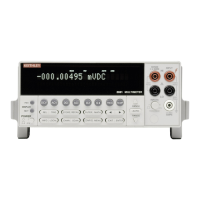IEEE-488 Reference
4-193
After this command is sent and the Model 2001 is addressed to talk, the “oldest” message in the
queue is sent to the computer.
Note: The :STATus:QUEue[:NEXT]? query command performs the same function as the
:SYSTem:ERRor? query command (see System subsystem).
Programming example The following program will read the “oldest” message in the Error Queue:
5 DIM A$ [30]
10 OUTPUT 716; “:stat:que?”
20 ENTER 716; A$
30 PRINT A$
40 END
Line 5 Increase string size to accommodate the length of the messages.
Line 10 Requests the “oldest” message in the queue.
Line 20 Addresses the Model 2001 to talk.
Line 30 Displays the message on the CRT.
ENABle <list>
:STATus:QUEue:ENABle <list> Enable messages for Error Queue
Parameter <list> = (numlist)
where; numlist is a specified list of messages that you wish to enable for the Error Queue.
Format :stat:que:enab (numlist)
Defaults Power-up Clears list
*CLS No effect
:STATus:PRESet No effect
Query :ENABle? Query list of enabled messages
Short-form format: :stat:que:enab?
Response message: numlist
Description On power-up, all error messages are enabled and will go into the Error Queue as they occur.
Status messages are not enabled and will not go into the queue. This command is used to specify
which messages you want enabled. Messages not specified will be disabled and prevented from
entering the queue.
When this command is sent, all messages will first be disabled, then the messages specified in
the list will be enabled. Thus, the returned list (:ENABle?) will contain all the enabled messages.
Messages are specified by numbers (see Table 3-4). The following examples show various forms
for expressing a message numlist:
Numlist = -110 Single message.
= -110, -140, -222 Messages separated by commas.
= -110:-222 Range of messages (-100 through -222).
= -110:-222, -230 Range entry and single entry separated by a comma.

